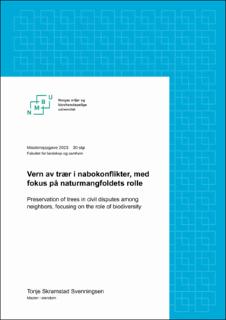| dc.contributor.advisor | Einar Bergsholm | |
| dc.contributor.author | Svenningsen, Tonje Skramstad | |
| dc.date.accessioned | 2023-07-19T16:28:03Z | |
| dc.date.available | 2023-07-19T16:28:03Z | |
| dc.date.issued | 2023 | |
| dc.identifier | no.nmbu:wiseflow:6839533:54591846 | |
| dc.identifier.uri | https://hdl.handle.net/11250/3080271 | |
| dc.description.abstract | Tema for oppgaven er “trær på naboeiendom”, og i denne masteroppgaven vil det ses nærmere på hva slags vern trær har i nabokonflikter, med et særlig fokus på naturmangfoldets rolle.
Uenigheter rundt naboens trær er en av de vanligste årsakene til nabokonflikter, og har vært det lenge. Man har i naboretten et alminnelig prinsipp som går ut på at man som eier av en eiendom har rett til å disponere over denne slik man selv måtte ønske, men det er likevel slik at etter gjeldende rett har ikke treeieren suveren rådighet over sin egen eiendom. På den ene siden er det viktig å ta hensyn til at grunneier får muligheten til å utnytte og bruke sin egen eiendom, mens på den andre siden er det også viktig at naboenes ve og vel, så vel som hensynet til samfunnet for øvrig, blir ivaretatt.
Rettslig sett vil spørsmålet være om naboen kan kreve at treeier feller eller beskjærer trær som er til skade eller ulempe for vedkommendes eierrådighet. Naboloven har tre bestemmelser som gjelder trær på naboeiendom. Naboloven § 2 angir den alminnelige tålegrensen i naboforhold, naboloven § 3 gjelder for nærstående trær, mens § 12 gjelder for trær, greiner eller røtter som stikker inn på naboeiendommen. Naturmangfoldet skal vurderes etter både naboloven §§ 2 og 3, og etter nabolovens bestemmelser virker trær å ha et relativt sterkt vern.
Det er imidlertid slik at det ikke bare er nabolovens bestemmelser som regulerer trærs vern i nabokonflikter. Det er et stort fokus på å få til minnelige løsninger i nabokonflikter, noe som medfører at partene kan inngå avtale uten å ta hensyn til nabolovens bestemmelser. Allikevel er det slik at naturmangfoldloven, plan- og bygningsloven og servituttloven alle har bestemmelser, med bakgrunn i naturmangfoldet, som kan legge føringer for konfliktenes løsning, og være med på å gi trær vern selv når nabokonfliktene løses i minnelighet. | |
| dc.description.abstract | The topic of this thesis is “trees on a neighboring property”, and this master's thesis will take a closer look at what kind of preservation trees have in civil disputes among neighbors, with a particular focus on biodiversity.
Disagreements about the neighbor's trees are one of the most common causes of civil disputes among neighbors, and have been for a long time. There is a general principle in neighboring law which states that as the owner of a property, you have the right to dispose of it as you wish, but it is still the case that according to current law, the tree owner does not have sovereign control over its own property. On one hand, it is important to take into account that the landowner gets the opportunity to exploit and use its own property, while on the other hand, it is also important that the well-being of the neighbors, as well as the interests of the rest of the society, are taken care of.
From a legal point of view, the question will be whether the neighbor can demand that
that the tree owner removes or crops trees that are harmful or disadvantageous to his right of ownership. The Neighborhood Act has three provisions that apply to trees on neighboring property. The Neighborhood Act § 2 sets out the general tolerance limit in neighboring relationships, § 3 applies to nearby trees, while § 12 applies to trees, branches or roots that protrude into the neighboring property. Biodiversity must be assessed according to both §§ 2 and 3, and according to the provisions of the Neighborhood Act, trees appear to have relatively strong protection.
However, it is not only the provisions of the Neighborhood Act that regulate the preservation of trees in neighborhood conflicts. There is a great focus on achieving amicable solutions in civil disputes among neighbors, which means that the parties can enter into an agreement without taking into account the provisions of the Neighborhood Act. Nevertheless, it is the case that the Biodiversity Act, the Planning and Building Act and the Easements Act all have provisions, with a background in biodiversity, which can be included for the resolution of disputes, and help give the trees preservation even when the civil disputes among neighbors are resolved amicably. | |
| dc.language | nob | |
| dc.publisher | Norwegian University of Life Sciences | |
| dc.title | Vern av trær i nabokonflikter, med fokus på naturmangfoldets rolle | |
| dc.type | Master thesis | |
